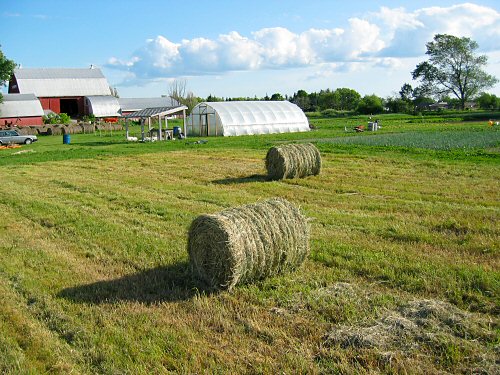
The garden, approaching 2.5 acres with this year’s addition, floats near one corner of a 9 acre field of hay. I could fairly easily expand into much more of the field, and ride around all day, machine seeding and cultivating. This is definitely not the plan. Instead, it’s stay small in area and add people—I’m somehow attached to the idea that, in a pinch, I could still (with help!) manage the whole thing without gas-powered machines…more or less. So, twice a season, Bob cuts and bales the hay that’s all around, using 30-year-old big tractor gear, carefully kept up over the decades. Since the whole farm is certified organic, I suppose we could find a specialty market for “organic hay”, but that seems a little precious—this stuff gets fed to the half dozen cows, couple of dozen goats, and single miniature donkey, who live to eat and loaf on other parts of the tiny farm (I call ’em 10,000 lbs of pet…they’re Bob and Karen’s, it’s not I who takes care of ’em!). This field is overdue for reseeding, the hay has lots of grass that’s grown into the diminishing clover and alfalfa. Oh, you can also see Conall’s old Volvo station wagon, in the parking circle mowed out of the hay in front of the stand—it’s rapidly become part of the season’s local errand routine (it will lose some character when he gets that rear bumper reattached). And that’s the hay story.




miniature donkey???
this busy season may be the wrong time, but a pet section would be nice.
It’s really great to see that your focus on keeping it people oriented. I really really enjoy reading your experiences of doing something that I may do sometime. In the meantime I’m learning alot from this blog. Theres tons of gardening books but the whole picture is why I really like your blog. Your doing everything and documenting it well
Relying on the people instead of machines makes alot of sense. Alot of the farmers (mostly dairy) around me (upstate ny) all rely on gas powered machines that sit idle most of the season ( alot of deperiation on a 80k- 150k machine) I guess you have to sell alot of milk to cover those expenses. Not to mention when they have to fix the tractors and do maintenece like replace tires etc. When your fixing and worrying about equiment and paying a huge price for it ..it seems a bit disconnected from what a farm is about? So thanks for sharing with the world your experiences. One thing I’d be curious to read is any info you’d be willing to share about the monetary end of running a small farm. I’d complelty understand if you didn’t want to share, however that’s a part of a farm just like veggies..
GREAT BLOG TY!!!!
Jeff in nY
Hey Jeff: Thanks!
My idea of what should be in a tiny farm journal keeps evolving as I go along. A few weeks back, I realized that, for me at least, there is no separation between the production/gardening and the marketing/selling (CSA, farmers’ market, farm stand). Maybe one could get satisfaction from veggie garden without tasting or eating the harvest, but that seems doubtful. In tiny farming, the people you sell your harvest to are to me extensions of that, they complete the veggie garden! I tried to get at that idea in the “CSA shares…” post.
On the more direct monetary end, the situation here is not conveniently clearcut, so I can’t provide a simple answer. I’ll probably get to that as time goes by. :) For sure, this isn’t a hobby farm, it’s gotta pull its own weight.
And then there’s the “square foot” model I often get in conversations about. If you look at a field in square foot units, include the growing bed area only, and come up with a number, you can plan for gross revenue in a veggie-friendly way. For example, take a round 40,000sq ft as an acre. If you could get, say, $2 per square foot, that’d be $80K a year per acre. Use your garden production imagination and some arithmetic and you can see that quite a bit is possible financially. For example, say you get a $4 bag of mesclun and a $1.50 bunch of radishes out of a sq ft each, that’s $2.75/sq ft and you’re already ahead of the $2 target. And so on… (I’m NOWHERE NEAR that, or of planning and record-keeping with that sort of…precision, but it’s at least a nice overall musing framework.) It makes economic sustainability seem…doable!
Hope that all makes some sense, I’m writing quickly on a heat break!!
Yeah Mike it makes a lot of sense. When your as diverse as you are growing crops, it would be harder then say ALL corn or ALL soy on the land to figure out a dollar amount per sq. ft. Not to mention that certain crops would take longer to harvest which factors into your time invested per $ return ( not that that’s the only thing to consider what you plant). I can see why you use the sq ft model as only a frame work, it just seems to intensive to keep figures that way for a Tiny very diverse farm.
Jeff in nY